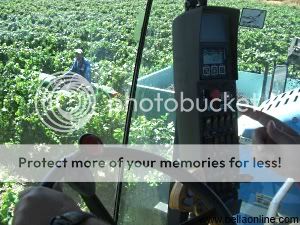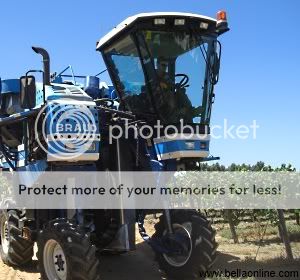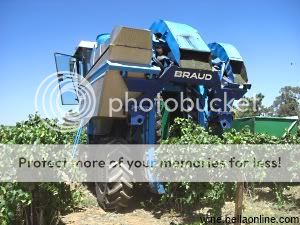Riding a Machine Harvester

The vehicle was travelling at 2km (1¼ miles) per hour and I was hanging on for dear life. It was the ride of a lifetime.
In the cab was Philip Viljoen. He’d been driving since 3am and, if all went well, he would finish at 5pm. He had just two days to harvest his eight hectare Pinotage vineyard and that was why he was working fourteen-hour days.

There is only a seat for the driver in a machine harvester. I was standing on a narrow ledge outside holding onto a grab rail. The harvester is tall. It straddles one row of grapes, vibrating the vines with long fibreglass rods so individual berries fall off into a tray. They are carried up on conveyor belts and either drop into a storage bin on the harvester or out on an extension of the conveyor across the vine row and into a trailer being pulled by a tractor matching speed alongside.
The integral bin would be filled before the long row was harvested and that would mean a delay while it was emptied and Paul had no time for delays so the bin was used just for the few minutes when the tractor’s bins were full and another replaced it. Paul just kept going, except for the few minutes when he kindly stopped to let me clamber onboard and later to get off.


Wine lovers argue the pros and cons of hand versus machine harvesting. Some wine labels bear the words ‘hand picked’ as a claim of quality. But hand picked has two meanings and it’s wrong in this case to think it means especially selected. Grape pickers being paid by the weight of grapes they pick don’t have the luxury of selecting only the best berries; they cut every bunch into their basket.
Whether grapes are machine or hand harvested, the real selection is done at the winery, either by running berries along a conveyor belt between teams of people or increasingly by expensive and clever computer controlled laser sorters.
And while it may be thought that hand harvesting is more gentle on the grapes, remember that bunches so picked go into a vibrating machine that strips berries off their stalks — just like the machine harvester.
Me? I don’t think it matters if grapes are hand or machine harvested. It is what is selected and what is rejected at the winery that is important.
Ask questions and talk about wine on our forum.
Thanks to Philip Viljoen, owner of Oubenheim Wine Estate, for the ride, Heine Janse van Rensburg (viticulturist) & especially Len Knoetze (Production Manager) of Namaqua Wines and the Pinotage Association for making it possible by hosting my visit to Namaqua Wines wineries and vineyards in the Olifants River region. Peter F May travelled to Olifants River in South Africa at his own expense.
In the cab was Philip Viljoen. He’d been driving since 3am and, if all went well, he would finish at 5pm. He had just two days to harvest his eight hectare Pinotage vineyard and that was why he was working fourteen-hour days.

There is only a seat for the driver in a machine harvester. I was standing on a narrow ledge outside holding onto a grab rail. The harvester is tall. It straddles one row of grapes, vibrating the vines with long fibreglass rods so individual berries fall off into a tray. They are carried up on conveyor belts and either drop into a storage bin on the harvester or out on an extension of the conveyor across the vine row and into a trailer being pulled by a tractor matching speed alongside.
The integral bin would be filled before the long row was harvested and that would mean a delay while it was emptied and Paul had no time for delays so the bin was used just for the few minutes when the tractor’s bins were full and another replaced it. Paul just kept going, except for the few minutes when he kindly stopped to let me clamber onboard and later to get off.


Wine lovers argue the pros and cons of hand versus machine harvesting. Some wine labels bear the words ‘hand picked’ as a claim of quality. But hand picked has two meanings and it’s wrong in this case to think it means especially selected. Grape pickers being paid by the weight of grapes they pick don’t have the luxury of selecting only the best berries; they cut every bunch into their basket.
Whether grapes are machine or hand harvested, the real selection is done at the winery, either by running berries along a conveyor belt between teams of people or increasingly by expensive and clever computer controlled laser sorters.
And while it may be thought that hand harvesting is more gentle on the grapes, remember that bunches so picked go into a vibrating machine that strips berries off their stalks — just like the machine harvester.
Me? I don’t think it matters if grapes are hand or machine harvested. It is what is selected and what is rejected at the winery that is important.
Ask questions and talk about wine on our forum.
Thanks to Philip Viljoen, owner of Oubenheim Wine Estate, for the ride, Heine Janse van Rensburg (viticulturist) & especially Len Knoetze (Production Manager) of Namaqua Wines and the Pinotage Association for making it possible by hosting my visit to Namaqua Wines wineries and vineyards in the Olifants River region. Peter F May travelled to Olifants River in South Africa at his own expense.

Related Articles
Editor's Picks Articles
Top Ten Articles
Previous Features
Site Map
Content copyright © 2023 by Peter F May. All rights reserved.
This content was written by Peter F May. If you wish to use this content in any manner, you need written permission. Contact Peter F May for details.



